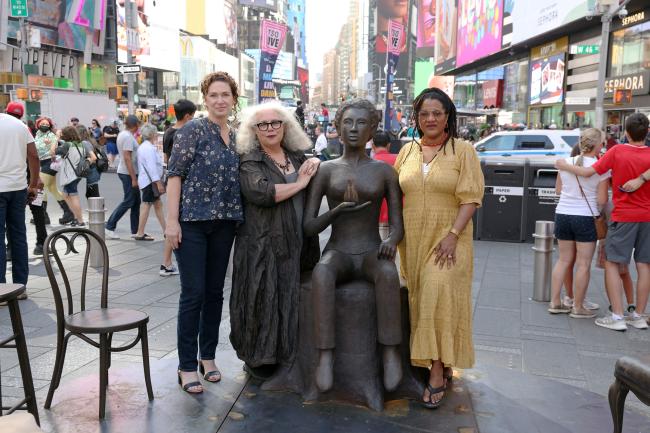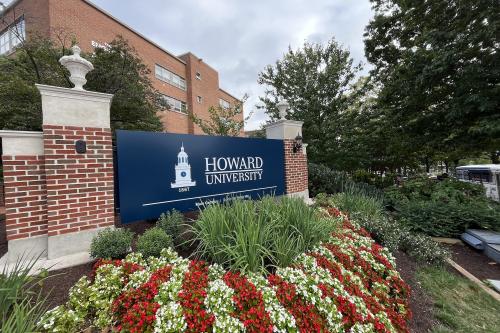WASHINGTON – A statue of the great American playwright and civil rights leader Lorraine Hansberry, created by the renowned sculptor Alison Saar, was installed at Howard University on October 26. The statue was created earlier this year as part of the Lorraine Hansberry Initiative, which aims to honor Lorraine’s legacy while investing in those following in her footsteps. Titled “To Sit Awhile,” the statue features the figure of Hansberry surrounded by five bronze chairs, each representing a different aspect of her life and work. The life-size chairs are an invitation to the public to do just that: sit with her and think.
The statue was unveiled in a ceremony in New York City’s Times Square on June 9, 2022, which featured a performance from Tony Award-winner LaChanze; and remarks from Pulitzer Prize-winning playwright, Lynn Nottage; Lorraine’s great niece, Taye Hansberry; and the Lillys’ executive director, Julia Jordan. It then traveled across the city with stops in Times Square, the Schomburg Center for Research in Black Culture, and Brooklyn Bridge Park.
Howard University’s Chadwick A. Boseman College of Fine Arts Department of Theatre Arts will lead programming on Hansberry’s life to include:
November 17, 2022
Lorraine Hansberry: The Nexus of Identity, Politics and Art
Lecture by Hansberry ScholarProf. Jordan Ealeyon the life, times, and legacy of Lorraine Hansberry's work and impact on culture.
The Legacy of Hansberry’s Plays
Discussion with Phylicia Rashad; Tarell McCraney; Dana Williams, Ph.D.; and moderated by Nikkole Salter, chair of the Theatre Arts department; about the impact of her dramatic narrative on American culture.
November 18, 2022
The Art of Politics and the Politics of the Public: A Conversation with Alison Saar
Julia Jordan talks virtually with Alison Saar about the genesis and meaning of the sculpture, moderated by Kathryn Coney Ali and Raul Moarquech Ferrera-Balanquet, Ph.D.
Sculpture, Architecture and Monument
Lecture by Melanee Harvey, Ph.D. on the role of public art/sculpture in political movement.
Panel discussion moderated by Melanee Harvey, Ph.D. featuring Raimi Gbadamosi, Ph.D. ;Akili Ron Anderson;Bradford Grant; and Martha Jackson Jarvis.
The statue will remain in Washington, D.C. for public viewing through December 12, 2022, following installations in Detroit (Charles H. Wright Museum of African American History), Minneapolis (Pillsbury House Theatre), and a return to New York (Astor Place) in conjunction with The Public Theater’s current production of “A Raisin in the Sun.” After the Howard University installation, the sculpture continues a nationwide tour, with stops in major cities across the country, including Atlanta, Seattle, Houston, San Francisco, Los Angeles, and Chicago. As the birthplace of Hansberry and the setting of “A Raisin in the Sun,” Chicago will enjoy an augmented and permanent installation in 2023.
In addition, the Lorraine Hansberry Initiative has created a unique scholarship to make sure that the next generation is able to follow in Hansberry’s footsteps, regardless of race, gender, or economic situation. This singular grant willcover the living expenses of three female and/or non-binary dramatic writers of color entering graduate school, with two additional recipients added each year. Each recipient will receive $25,000 for each year of their education, ensuring that they have protected time to write, work with collaborators, and benefit from the guidance of professional mentors in their respective fields. They will go on to create for the stage, television, and film, and their work will reach millions.
The Lorraine Hansberry Initiative Leadership Council includes Liz Armstrong, David Binder, Michelle T. Boone, Lily Fan, Kamilah Forbes, Mandy Greenfield, Agnes Gund, Mamie Hansberry, Nantille Hansberry Charbonnet, Taye Hansberry, David Henry Hwang, Branden Jacobs-Jenkins, Alia Jones-Harvey, Julia Jordan, Anne Kauffman, Renee Landegger, Kenny Leon, Emily Mann, Jaimie Mayer, Stacey Mindich, Dominique Morisseau, Marsha Norman, Lynn Nottage, Antoinette Nwandu, Robert O’Hara, Imani Perry, Charles Randolph-Wright, LaTanya Richardson Jackson, Jane M. Saks, Jayne Baron Sherman, Seret Scott, Pauletta Washington, George C. Wolfe, and Charlayne Woodard.
Lead support has been provided by the Dramatists Guild, the Ford Foundation, the Nathan Cummings Foundation, National Endowment for the Arts, the Shubert Foundation, Grantmakers for Girls of Color, Liz Armstrong, Agnes Gund, Stacey Mindich, Jayne Baron Sherman, Leslie Simpson, and Daniel M. Ziff.
The entire Lorraine Hansberry Initiative is budgeted at $3,500,000. To date, over $2,600,000 has been raised. To make a donation to support this important work, please visit https://lorrainehansberryinitiative.org/donate.
###
About Howard University
Founded in 1867, Howard University is a private, research university that is comprised of 14 schools and colleges. Students pursue more than 140 programs of study leading to undergraduate, graduate and professional degrees. The University operates with a commitment to Excellence in Truth and Service and has produced one Schwarzman Scholar, four Marshall Scholars, four Rhodes Scholars, 12 Truman Scholars, 25 Pickering Fellows and more than 165 Fulbright recipients. Howard also produces more on-campus African American Ph.D. recipients than any other university in the United States. For more information on Howard University, visit www.howard.edu.
About the Lorraine Hansberry Initiative
In 1959, Lorraine Hansberry became the first Black female playwright on Broadway with her play A Raisin in the Sun. It continues to be one of the most produced plays in the world, but Hansberry’s contribution to the world was far greater than that single play. Her entire body of work as an artist, journalist, and civil rights leader has proven to be as incisive and relevant today as it was during her short lifetime and deserves to be studied and revered as such.
Over 60 years later, female playwrights of color remain the most proportionally underrepresented demographic on American stages. Despite making up 20% of the population, holding 20% of the undergraduate degrees in English literature and in the performing arts, and being chosen by their peers for over 20% of the spots in national playwright organizations, prior to this unusual year following the murder of George Floyd, they only accounted for under 10% of professional productions.
Through this initiative, we will keep the current national conversation about race, justice, and economic equality going by honoring Lorraine Hansberry. We will add to the growing movement to honor women and people of color with physical monuments. And we will alleviate the financial inequality that discourages women and non-binary playwrights of color from pursuing graduate degrees in her chosen art form.
Media Contact: Aaliyah Butler; aaliyah.butler@howard.edu





